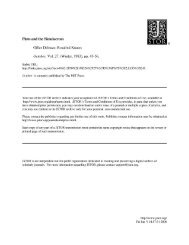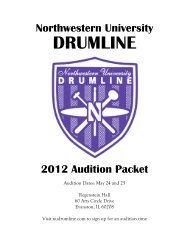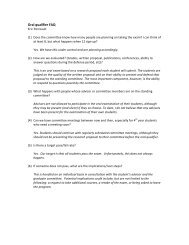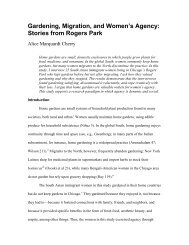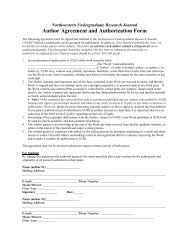research - Associated Student Government, Northwestern University
research - Associated Student Government, Northwestern University
research - Associated Student Government, Northwestern University
Create successful ePaper yourself
Turn your PDF publications into a flip-book with our unique Google optimized e-Paper software.
RESEARCHSection III. DataAll data have been obtained for the years 1984 to 2007. Imports and exports are annual data obtained fromComtrade, a United Nations publication, and are reported in nominal US dollars. Exchange rate data were obtainedfrom the International Monetary Fund’s publication, International Financial Statistics. Real GDP, the GDP deflator,and Consumer Price Index data were obtained from the IMF’s World Economic Outlook database. The manufacturingprice index used to construct a relative price index uses value-added data and was obtained from the Bureau ofEconomic Analysis’s National Economic Accounts. The availability of data for only twenty-four years on an annualbasis for all variables is a limiting factor in my regression analysis especially due to several lagged variables, yet in hisstudy previously mentioned, Tuck finds very significant results using only thirty years starting in 1970, when Chinesedata are even less reliable. As far as the reliability of my own data goes, I am skeptical of China’s reporting of datain general as the authoritarian government has incentive to misrepresent figures in order to maintain a good image.Thus, I have constructed my framework so that I may rely on data from United States sources or internationalorganizations when possible. The Chinese data that I do use, especially consumer price index, have been released bythe IMF, so I believe them to be the best available. Ideally, I would be able to use quarterly or even monthly data toincrease the number of observations and trace the effects of exchange rate and price adjustments that occur duringonly part of a given year. This would be especially important as I believe that the effect of Chinese price data mayhave been skewed by the two inflationary spikes that occurred in late 1988 and into 1989 as well as 1993 through1995.Section IV. Vector Error Correction ModelEconomic theory tell us that there should be interaction between the real GDPs, relative prices, nominal exchangerates and trade balances both within and between countries via trade. These variables potentially contain feedbackloops in which an effect on one variable affects another, which affects another until the singular change has an effecton the entire system. One problem with this analysis is that the short-term dynamics and interaction between thevariables is unclear. To study the short-term effects, I used my model to create impulse response graphs for eachof the variables to show how they would react to a nominal appreciation or a real increase in Chinese prices relativeto those in the US. However, within each year the dynamics of the variables are unknown due to the fact that onlyannual data are available for China over the entire time period. The vector error correction model can be used tocorrect for non-stationarity in variables as discussed above. In order to construct a functional vector error correctionmodel several choices had to be made including the number of lagged independent variables as well as the numberof cointegrating vectors to include. These decisions were constricted by the limitations in the size of the data set aseach lag or cointegrating vector represents a valuable degree of freedom for estimating the model. To make thesedecisions, I used Johansen’s test for the number of cointegrating vectors as shown below.Using a similar methodology to Yusoff (2009), the vector error correction model for US-China trade can bewritten as:ΔZt = β0 + λ ECTt-1+ β1 ΔTBt-1+ β2 ΔlnCRGDP t-1+ β3ΔlnUSRGDPt-1 + β4ΔlnRERt-1 + εtwhere Δ is the first-difference operator, Z = {TB lnCRGDP lnUSRGDP lnRER}, with one lag for each of theexplanatory variables, and ECT is the error-correction term. TB is the value in trillions of dollars of US net exportsto China, lnCRGDP, is the natural logarithm of China’s real GDP denominated in trillions of RMB, lnUSRGDP isthe natural logarithm of real GDP of the US denominated in trillions of dollars, and lnRER is the natural logarithmof the real exchange rate calculated by multiplying the nominal exchange rate in Dollars per Yuan by China’s GDPdeflator (a proxy for prices in China) and dividing by the US GDP deflator (a proxy for US prices).In order to decide how many cointegrating vectors to use in the vector error correction model, I used Johansen’stest for the number of cointegrating vectors. This test rejected at the 5% confidence level the hypothesis that nocointegrating equations are present in the model but failed to reject the hypothesis that at most one cointegratingequation should be included. The 5% critical value is the value above which you can reject the hypothesis with 95%22 NORTHWESTERN UNDERGRADUATE RESEARCH JOURNAL




